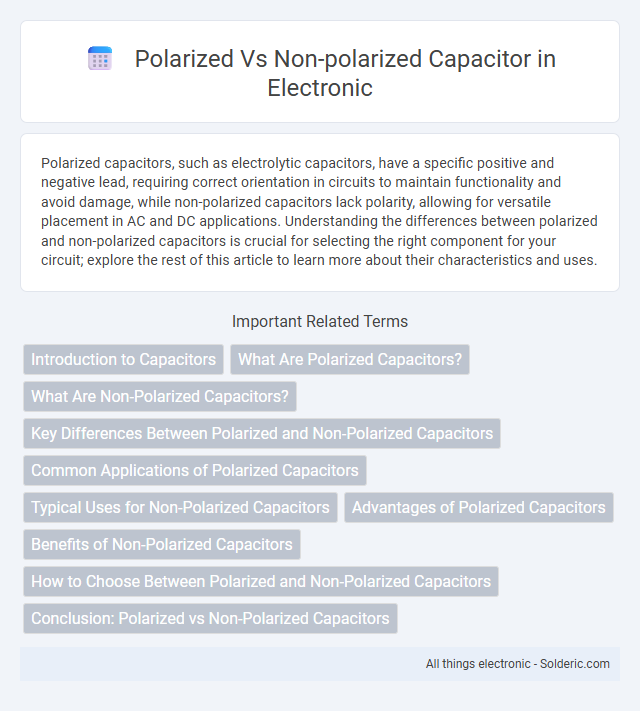Polarized capacitors, such as electrolytic capacitors, have a specific positive and negative lead, requiring correct orientation in circuits to maintain functionality and avoid damage, while non-polarized capacitors lack polarity, allowing for versatile placement in AC and DC applications. Understanding the differences between polarized and non-polarized capacitors is crucial for selecting the right component for your circuit; explore the rest of this article to learn more about their characteristics and uses.
Comparison Table
| Feature | Polarized Capacitor | Non-Polarized Capacitor |
|---|---|---|
| Polarity | Has positive and negative terminals (must be connected correctly) | No polarity, can be connected in any direction |
| Capacitance Range | Typically high (uF to mF) | Usually low to medium (pF to uF) |
| Voltage Rating | Lower voltage ratings (typically up to 50V-100V) | Higher voltage ratings (up to hundreds or thousands of volts) |
| Common Types | Electrolytic, Tantalum | Ceramic, Film, Mica |
| Application | Used in DC circuits for filtering, smoothing | Used in AC circuits, RF circuits, coupling and bypass |
| Cost | Generally cheaper for higher capacitance | More expensive per uF at higher values |
| Size | Larger size for given capacitance | Smaller size for given capacitance (at low values) |
| Leakage Current | Higher leakage current | Very low leakage current |
Introduction to Capacitors
Capacitors store electrical energy by accumulating opposite charges on two conductive plates separated by a dielectric material. Polarized capacitors, such as electrolytic types, have a designated positive and negative terminal and are used primarily in DC circuits, while non-polarized capacitors, like ceramic or film capacitors, can be connected in any direction and are suitable for AC applications. Understanding the differences between polarized and non-polarized capacitors is essential for selecting the right component based on voltage polarity, frequency, and circuit requirements.
What Are Polarized Capacitors?
Polarized capacitors, such as electrolytic and tantalum types, have distinct positive and negative terminals, making correct polarity essential for proper operation and preventing damage. These capacitors typically offer higher capacitance values, ranging from 1 uF to several thousand uF, and are commonly used in power supply filtering, audio equipment, and DC voltage applications. Non-polarized capacitors, in contrast, lack polarity and are preferred in AC circuits and applications requiring bidirectional voltage handling.
What Are Non-Polarized Capacitors?
Non-polarized capacitors are electronic components that can operate with alternating current (AC) or direct current (DC) without a specified polarity, allowing them to be connected in any direction within a circuit. Common types include ceramic, film, and mica capacitors, which offer stable capacitance values and low equivalent series resistance (ESR), making them ideal for AC signal coupling, filtering, and timing applications. Their ability to handle AC signals without degradation distinguishes them from polarized capacitors like electrolytic types, which require correct polarity to function safely and efficiently.
Key Differences Between Polarized and Non-Polarized Capacitors
Polarized capacitors, such as electrolytic types, have a specific positive and negative terminal, making them suitable for DC circuits where correct polarity is critical for operation and longevity. Non-polarized capacitors, like ceramic or film capacitors, can be connected in any direction, supporting AC applications and signal coupling without polarity concerns. Key differences include their voltage ratings, capacitance stability, and usage in filtering, timing, and tuning circuits.
Common Applications of Polarized Capacitors
Polarized capacitors, such as electrolytic and tantalum types, are commonly used in power supply filtering, audio signal coupling, and energy storage applications due to their high capacitance values and voltage ratings. Your electronic circuits benefit from their ability to smooth voltage fluctuations and store charge efficiently in DC environments, making them ideal for power regulation and audio equipment. These capacitors are less suitable for AC or high-frequency circuits, where non-polarized capacitors like ceramic or film types are preferred.
Typical Uses for Non-Polarized Capacitors
Non-polarized capacitors are commonly used in AC signal applications, such as audio circuits, RF circuits, and coupling or decoupling where signal polarity varies. They are ideal for filtering, tuning, and timing tasks in both analog and digital electronics because they can handle voltage reversed polarity without damage. Your electronic designs benefit from non-polarized capacitors when stability and reliability in bi-directional current flow are critical.
Advantages of Polarized Capacitors
Polarized capacitors offer higher capacitance values in smaller sizes, making them ideal for power supply filtering and energy storage applications. Their ability to maintain stable voltage and low equivalent series resistance (ESR) enhances performance in audio circuits and signal processing. You benefit from improved efficiency and reliability in DC circuits by choosing polarized capacitors.
Benefits of Non-Polarized Capacitors
Non-polarized capacitors offer the benefit of being able to handle AC signals and reverse voltage without damage, making them versatile for various applications such as audio equipment and signal processing. They provide stable performance in circuits that experience polarity changes, enhancing reliability and longevity. Your choice of non-polarized capacitors ensures flexibility in AC filtering and coupling tasks where polarity sensitivity could cause failure.
How to Choose Between Polarized and Non-Polarized Capacitors
Choosing between polarized and non-polarized capacitors depends primarily on the application voltage and signal type. Polarized capacitors, such as electrolytic capacitors, are ideal for DC circuits requiring high capacitance values, but they cannot handle AC signals or reverse voltage without damage. Non-polarized capacitors, including ceramic and film types, support AC signals and are preferred for coupling, decoupling, and filtering in AC or mixed signal environments where polarity reversal might occur.
Conclusion: Polarized vs Non-Polarized Capacitors
Polarized capacitors, such as electrolytic types, offer high capacitance values in compact sizes but require correct polarity connections to function properly. Non-polarized capacitors provide versatility in AC applications and signal processing due to their ability to handle voltage reversals without damage. Your choice between polarized and non-polarized capacitors depends on the specific circuit requirements, including voltage conditions and capacitance needs.
Polarized vs non-polarized capacitor Infographic

 solderic.com
solderic.com